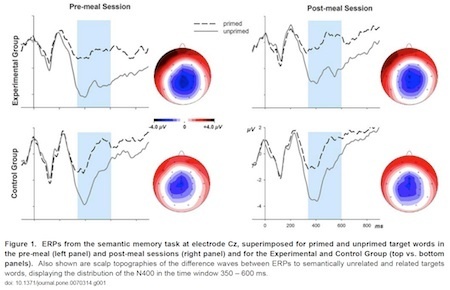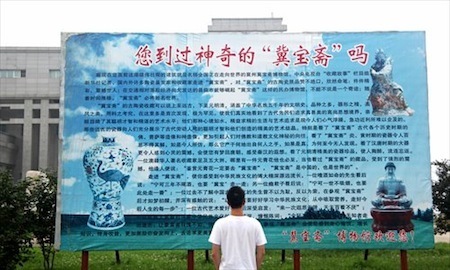Marc Abrahams's Blog, page 474
August 1, 2013
“How about lunch?” (new academic study)
This new study offers possibly deep insights into lunch:

Prof. Dr. rer. soc. habil. Werner Sommer
“How About Lunch? Consequences of the Meal Context on Cognition and Emotion,” Werner Sommer [pictured here], Birgit Stürmer, Olga Shmuilovich, Manuel Martin-Loeches, Annekathrin Schacht, PLoS ONE, vol. 8, no. 7, 2013, e70314. The authors, at Humboldt-Universität zu Berlin, Germany, International Psychoanalytic University, Berlin, UCM-ISCIII, Madrid, Spain, Complutense University of Madrid, and the University of Göttingen, Germany, explain:
“Although research addresses the effects of a meal’s context on food preference, the psychological consequences of meal situations are largely unexplored. We compared the cognitive and emotional effects of a restaurant meal eaten in the company of others to a solitary meal consumed in a plain office using pre- and post-tests analysis and controlling for the kind and amount of food consumed. Three tasks were conducted, measuring: (1) semantic memory (2) cognitive control and error monitoring, and (3) processing of emotional facial expressions…. These findings provide the first experimental evidence that a restaurant meal with a social component may be more relaxing than a meal eaten alone in a plain setting and may reduce cognitive control.”
Further detail from the study:
(Thanks to investigator E. Weller for bringing this to our attention.)
BONUS (perhaps unrelated): Video of “I Love Lunch! The Musical”:

The stimulating job of cataloguing (Kinsey)
Pamela Pierce, writing in Girls Like Giants, tells of and wonders at how she went about cataloguing the work of a famous sex research joint:
I started a Master’s in Library Science at Indiana University in Bloomington and began working at the Kinsey Institute for Research in Sex, Gender, and Reproduction. Founded in 1947, a year before the publication of Sexual Behavior in the Human Male, the center strives to “advance sexual health and knowledge worldwide.” Its collection of over 100,000 photographs, novelty items, paintings, collages, and artifacts is part of accomplishing that goal. I have created cataloging entries for pillow books from Japan, British condoms celebrating the marriage of Prince William to Kate Middleton, and ancient scrolls detailing Chinese sexual practices.
I love cataloguing at the Kinsey because it’s my job never to judge. My first task there was to describe a large collection of confiscated San Quentin-created erotica. Inmates in the California prison created erotic images they could experience behind bars using watercolors, parts of mattresses, the backs of moral guidance pamphlets, crayons, and pencils….
(HT Vaughan Bell)

Closed exhibitionists: The museum that had minimal reality
Reports pour in about the closing of a museum that had little in fact to commend it but much in fiction. The Global Times says (and supplies this photo):
Museum shut over fake exhibits
A museum in a village in Hebei Province has been shut down as most of its collections were reported to be fake, provincial cultural heritage authorities confirmed Monday.
The Jibaozhai Museum in Erpu village, Jizhou, has had its license revoked by Jizhou civil affairs bureau, and its mangers are under investigation, an official from Hebei Provincial Cultural Heritage Bureau, surnamed Li, told the Global Times….
Chinese museum found with 40,000 fake exhibits forced to close
A Chinese museum has been forced to close after claims that its 40,000-strong collection of supposedly ancient relics was almost entirely composed of fakes.
The 60 million yuan (£6.4 million) Jibaozhai Museum, located in Jizhou, a city in the northern province of Hebei, opened in 2010 with its 12 exhibition halls packed with apparently unique cultural gems.
But the museum’s collection, while extensive, appears ultimately to have been flawed. On Monday, the museum’s ticket offices were shut amid claims that many of the exhibits were in fact knock-offs which had been bought for between 100 yuan (£10.70) and 2,000 yuan (£215).
The museum’s public humiliation began earlier this month when Ma Boyong, a Chinese writer, noticed a series of inexplicable discrepancies during a visit and posted his findings online….
(Thanks to investigator G. Jules for bringing this to our attention.)

Misleading study title of the week: Sex and drinkers
This week’s Misleading Study Title of the Week is:
“Sex moderates stress reactivity in heavy drinkers” Emily E. Hartwell and Lara A. Ray [pictured here], Addictive Behaviors, vol. 38, no. 11, November 2013, pp. 2643–2646. The authors are at the University of California, Los Angeles.

July 31, 2013
Concerns about watching TV while driving: then and now
NOW: Stuff reports:
The [UK] Department for Transport has acted to ban drivers from using Google Glass – even before Google’s smart eyewear launches to the general public.
Stuff has learned that the government department is concerned about the potential for distraction that could result from using Google Glass while driving, and has taken pre-emptive action ahead of Google’s much trailed new hardware release, scheduled for 2014.
THEN: The 1993 Ig Nobel Prize for visionary technology was awarded to jointly to Jay Schiffman of Farmington Hills, Michigan, crack inventor of AutoVision, an image projection device that makes it possible to drive a car and watch television at the same time, and to the Michigan state legislature, for making it legal to do so. Here is a technical drawing from Mr. Schiffman’s patent:

Shhhhhhhhhhhh
The “Silences of Science” conference in London, which seems to have happened, quietly, on July 2-3, described itself thus:
The Silences of Science is an AHRC-funded research network examining different aspects of the paradox that science depends both on prolixity and on reticence.
Read about the full program.
(Thanks to investigator Tina Owens for bringing this to our attention.)
BONUS (unrelated): The Whispers Conference.

Understanding Stigma with a ‘Dogfood Sandwich’
Would you care for a dogfood sandwich? New research investigates this question with regard to ‘Stigma’. Previous investigators of ‘Stigma’ (e.g.Fallon et al., 1984; Rozin et al., 1985, 1986) have examined people’s reactions to cockroaches and ‘Hitler’s sweater’.
“For example, dipping a sterilized cockroach into a glass of juice lowered the average rating of the juice by more than 100 points.”
 The study (published in the journal Organization, Volume 92, August 2013, pp. 202–213) is authored by William Schulze (Kenneth L. Robinson Professor of Agricultural Economics at Cornell University, US), Annemie Maertens (Assistant Professor in the International Development at the University of Pittsburgh, US), and 2007 Ig Nobel Nutrition prize winner Brian Wansink (John Dyson Professor of Consumer Behavior at Cornell University, US) * see note [1] below. It examines humans’ propensity towards stigma by giving experimental subjects refreshment opportunities featuring sandwiches made from “gourmet cooked canned chicken thighs for dogs” and ice cream. (that’s separately, not together).
The study (published in the journal Organization, Volume 92, August 2013, pp. 202–213) is authored by William Schulze (Kenneth L. Robinson Professor of Agricultural Economics at Cornell University, US), Annemie Maertens (Assistant Professor in the International Development at the University of Pittsburgh, US), and 2007 Ig Nobel Nutrition prize winner Brian Wansink (John Dyson Professor of Consumer Behavior at Cornell University, US) * see note [1] below. It examines humans’ propensity towards stigma by giving experimental subjects refreshment opportunities featuring sandwiches made from “gourmet cooked canned chicken thighs for dogs” and ice cream. (that’s separately, not together).
The experimental procedure was fairly complex, so, in lieu of a summery, here’s an extract :
“In the case of the chicken dog food, the thighs were prepared by removing the skin, flaking and placing the pieces in a serving bowl so that the chicken could be used as any canned chicken would be for making sandwiches. As part of a ‘lunch experiment’ the respondents were offered the opportunity to purchase or be compensated to eat a chicken sandwich with their choice of bread and accouterments in three stages where more information was given and values were obtained at each of three stages beginning with a ‘canned chicken sandwich,’ followed by stages where either ingredients (chicken meat, chicken broth, kosher, no preservatives, and Kosher for Passover) or brand information (Evanger Super Premium for Dogs Whole Chicken Thighs) was revealed. The order of the second and third stage information was reversed in a subset of the sessions. Note that only the brand information revealed that the chicken was dogfood. In a subset of sessions we put the participants under cognitive load by asking them to look up (and memorize) the calorie content of eight food items on Google search. As part of the lunch experiment, participants were also given the opportunity to purchase or be compensated for eating vanilla ice cream following a similar design where initially they were only told the flavor of the ice cream, and then the brand (Walmart Fat Free Vanilla Flavored Ice Cream) and the ingredients were revealed.”
As part of their analysis, the team provide some mathematical representations :
“ … we can write the utility function that incorporates emotional utility for the decision to eat the chicken sandwich as:”
And, in conclusion :
“We find critical evidence of a dual process decision making process in which the absence of cognitive load allows the participants to deliberate over the health benefits of either food. In addition, in the case of the sandwich, there is an emotional component in which the positive emotion of surprise can partially offset the negative emotion of disgust. This has notable implications for addressing food safety fears related to contamination as well as the food neophobia related to unfamiliar foods, processing, or preparation.”
They do caution though, that a grain of salt might be required :
“Being under cognitive load increases the WTP [Willingness To Pay] but only when brand information is revealed in the brand first treatment (this effect is statistically significant at the 10% level using a t-test with unequal variances). This appears to contradict our hypothesis, but as many people opted out, i.e., they were not willing to accept even 20 USD, these averages need to be taken with a grain of salt, and hence we postpone discussion of the cognitive load for the time being.”
NOTES
[1] * Professor Wansink was awarded the 2007 Ig Nobel Nutrition prize for exploring the seemingly boundless appetites of human beings, by feeding them with a self-refilling, bottomless bowl of soup.
[2] Improbable has not been able to find Whole Chicken Thighs in Evanger’s Super Premium dogfood range so, for the photo we’ve used instead their “Whole Chicken Thighs – packed by hand!” product.
ALSO SEE: Pet projects : Can humans tell pâté from dog food? (The Guardian, Tuesday 26 May 2009)

July 30, 2013
Headline of the day: Less-controversial urine-derived teeth
Today’s Headline of the Day appears in Medical Daily:
Scientists Develop Urine Grown Teeth, Claiming Urine Is Less Controversial Source Of Stem Cells Than Embryos
The article goes on to begin to explain:
In the quest for regenerative medicine, a Chinese research team has found a novel way of growing human teeth, from stem cells taken from urine….
The team published a study, “Generation of tooth-like structures from integration free human urine induced pluripotent stem cells “, in the journal Cell Regeneration.
BONUS (unrelated): ”Smiling with dead men’s teeth“

Investment hint from Ig Nobel Prize winner Gideon Gono
Exciting investment news from Zimbabwe: Every now-nearly-worthless 100-trillion Zimbabwe dollar bill might, just might, soon be worth more than 100 trillion US dollars. Eyewitness News reports:
[President Robert ] Mugabe urged people who still have worthless Zimbabwe dollars not to tear them up, as they will be compensated.
Central Bank chief Gideon Gono told Mugabe many people still have Zimbabwe dollars in their homes. He said if elected into power next week, he will work out how to compensate people. Zimbabwe dumped its currency in 2009 and switched to the Rand and United States (US) dollar.
Mugabe says his party, Zanu-PF, plans to reintroduce the Zimbabwe dollar at some stage. If backed by gold, the local unit could be worth more than the US dollar, Mugabe said.
Gono, governor of Zimbabwe’s Reserve Bank, the man responsible for creating those bank notes, was awarded an Ig Nobel Prize in mathematics in 2009 for giving people a simple, everyday way to cope with a wide range of numbers — from very small to very big — by having his bank print bank notes with denominations ranging from one cent ($.01) to one hundred trillion dollars ($100,000,000,000,000).

NOTE (not about the bank notes): Gideo Gono’s web site seems to be under new ownership.

One-breast enlargement from German military rifle chest-slapping
The rhythmic impact of a rifle wielded by a military man can puff up his chest. This sometimes leads to worry, or worse. Though soldiers might appreciate a good pair of breasts, what would happen if they themselves grew a pair? Or if they grew just one?
Some men do experience this affront. A study called Gynecomastia in German Soldiers: Etiology and Pathology, published last year in the journal GMS Interdisciplinary Plastic and Reconstructive Surgery, analysed the plight of 211 male German soldiers who suffered from, or at least exhibited, one or two enlarged breasts. The ailment has a medical name: gynecomastia.
The study’s authors, Prof Björn Dirk Krapohl, Dr Dietrich Doll, and four colleagues at Bundeswehrkrankenhaus, the German Armed Forces Hospital in Berlin, played detective. They set out “to investigate the increased incidence of left-sided gynecomastia in members of the German Ministry of Defense Guard Battalion who perform ceremonial duties in Berlin.…
—So begins this month’s Improbable Research column in The Guardian. (NOTE: some of the comments from Guardian readers are rather entertaining.)

Marc Abrahams's Blog
- Marc Abrahams's profile
- 14 followers







